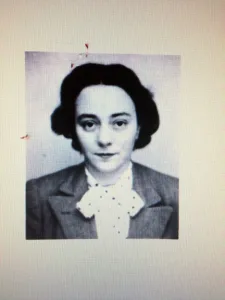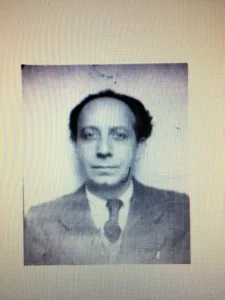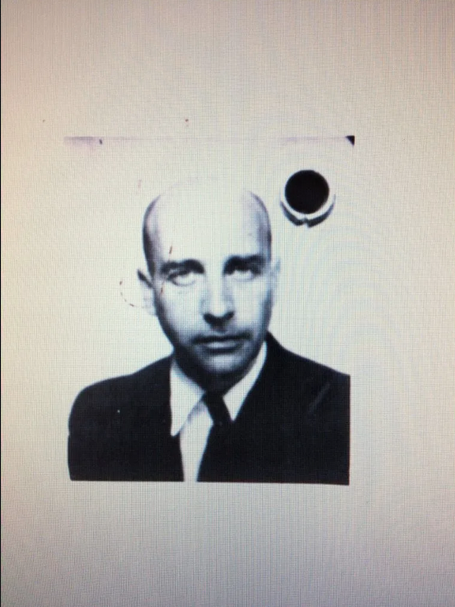Herbert HOFFMANN
Photo of Herbert Hoffmann
(APP_Gb-86-Affaire-HOFFMANN-Herbert-SUSSMANN-50)
Who was Herbert Hoffmann, a man who was deported on Convoy 77?
Herbert Hoffmann was born on November 8, 1904 in Vienna, Austria. His family was Jewish. He was one of the people who were deported on the last of the large transports from Drancy to Auschwitz-Birkenau, Convoy 77, on July 31, 1944. His parents were Maurice Hoffmann and Josephine Schnabel [1]. Over the course of his career, he worked in a variety of occupations, including those of interpreter, farmhand, bank clerk and glove-maker. Herbert Hoffman was also involved in Austrian Communist Party resistance activities in various European countries. After divorcing Marie Rocek, and having no children, he lived with Renée Cointe until he was arrested [2].
In 1935, having been made redundant, he left Austria for Brussels, in Belgium. There he ran a glove factory and had an office at 4 rue des Martyrs [3]. It was there that Hoffmann made contact with the Austrian Communist Party. He sold his business and donated the proceeds to the Austrian Communist Party, with which he worked closely. The party then paid him a regular sum of money to cover his living expenses [4].
When questioned, Herbert Hoffmann claimed to have left Belgium for Paris in November 1940 [5]. However, a man by the name of Guenser, when he was interrogated by the Germans, stated that Hoffmann had spent the summer of 1940 in Langlade, in the south of France, on a farm run by Otto Heller [6]. Heller was also an Austrian communist activist, and he too was deported on Convoy 77 [7].
In November 1940, Herbert Hoffmann arrived in Paris under the name “Heulieu”. He stayed there for a while, then went on to Toulouse, in the Haute-Garonne department of France, where he stayed in a hotel. In Toulouse, he met an old Communist comrade nicknamed “Richard”, and asked him to help him out financially. “Richard” introduced him to a man known as “Martin”, who the police later identified as Othmar Strobel. Some time later, Hoffmann and “Richard” moved to Luchon, also in the Haute-Garonne department, where they lived in a family-run boarding house. In March 1941, he and “Richard” left Luchon for Marseille, on the south coast of France[8].
When he got to In Marseille, Herbert rented an apartment at 27 rue de Crimée, in which he put up fellow Communists who were passing through. It was also in Marseille that Herbert Hoffmann met the Sussmanns, who lived in an apartment overlooking the old port [9].


The Sussmanns,
(APP_Gb-86-Affaire-HOFFMANN-Herbert-SUSSMANN-54 et 56)
In 1942, Herbert left Marseille for Paris, where he met up again with “Richard”. “Richard” then put him in touch with a woman known as “Edith”, who was later identified by the police as Antonie Lehr. She asked him to supervise two other women: “Claude”, who printed communist leaflets, and “Hellen”, who distributed them. Two months later, at the end of 1942, “Richard” asked him to end his involvement with the three women[10].

Antonie Lehr, who was known as “Edith”,
ottAPP_Gb-86-Affaire-HOFFMANN-Herbert-SUSSMANN-48
In March 1943, he was contacted by the wife of a fellow communist in Toulouse, who went by the name of “Martin”. Hoffmann was assigned the task of looking after him, so that he would not have to leave his home on Avenue de Choisy. In July 1943, Hoffman was left penniless again and “Martin” helped him out financially. He worked briefly as an interpreter for a German company, then decided to move to Bordeaux, in the Gironde department of France to look for work, but was unable to find any. In early September, he returned to Paris and got back his job with the German company. Some time later, “Martin’s” wife introduces him to a man who was probably German. The man told him he would put him in touch with someone in Brussels. He never saw the man again, despite having arranged to meet him twice at Motte-Piquet, but the man never showed up. From that moment on (September 1943), Herbert Hoffmann claimed to have been cut off from the Communist Party for good, and to have carried out no further covert political activity [11].
In 1944, he was spotted several times visiting the Sussmanns at their home at 43 rue Truffaut. The French police suspected that the Sussmans were communists and “notorious foreigners” and as a result, they were being investigated and monitored. The police then began to suspect Herbert Hoffman as well [12]. On May 10, 1944, the German authorities sent a report about Herbert Hoffman to the French police. This report, which was based on interrogations of various Communist resistance fighters, revealed Herbert Hoffmann’s involvement in illegal political activities [13]. As a result, he was arrested on May 12, 1944 together with his partner, Rénée Cointe, at her home at 12 bis Avenue d’Outrebon in Villemomble, in the eastern suburbs of Paris. The police found a number of forged documents (identity card, tobacco or food ration card, demobilization papers, birth certificate, work certificate) in the names of Van Howe and Heyndrixx, as well as an envelope containing two hundred Reichsmarks, but nothing of a political nature [14]. On May 13, a French Commissioner of Police called Fernand, questioned Hoffmann and his girlfriend. Hoffmann claimed to be a Roman Catholic and of “Aryan race” [15]. They were detained in the Seine jail [16]. After Renée Cointe was interrogated again on May 15, the Police Headquarters closed the case, but referred it immediately to the Special Brigade n°1 of the General Intelligence Service for further questioning by Inspector Thilloux[17]. The French police or the German authorities most likely discovered Herbert Hoffmann’s Jewish background during this investigation, as he was subsequently interned in Drancy camp on July 27 and deported to the Auschwitz-Birkenau death camp in Poland on July 31, 1944. He remained in the camp until his death[19].
This biography was written during the 2022-2023 school year by the 9th grade students of class 3eD at the 3rd D students at Christine de Pisan secondary school in Aulnay-Sous-Bois, in the Seine-Saint-Denis department of France. It was compiled from a collection of records held by the Police Headquarters in Paris, as part of the “Convoy 77” European project.
With the exception of one record from the Austrian archives (an extract from the Jewish register of births in the city of Vienna – “Vienna-DOW-Herbert-Franz-Hoffmann”), the students worked from one single file from the Paris Police Headquarters archives, entitled ” Case against Hoffmann Herbert and Cointe Renée”, which in turn came from a file labelled “GB086”. Each of the records in this file is referenced as “APP_Gb-86-Affaire-HOFFMANN-Herbert-SUSSMANN”, followed by the document number, and comprises mainly the search and arrest records of Herbert Hoffmann and his partner Renée Cointe, as well as their respective interrogations. These records were all produced by the same organization over a very short period of time, in May 1944. The information we have on Herbert Hoffmann therefore focuses on a short period of his life. The details of his interrogation, however, enabled us to retrace a significant part of his life, from the time he left Vienna in 1935 until he was arrested, ten years later. The students were alerted to the limitations of such a record from the outset. Some of Herbert Hoffmann’s lies and omissions were also revealed by referring to other invaluable material: the extract from Vienna’s Jewish birth register, for example, reveals the Jewish roots that Hoffmann tried to hide from the police by declaring himself to be “Aryan” and “a Catholic”. Interrogations of other Communist resistance fighters carried out by the German authorities confirm or contradict certain information given by Hoffmann. Finally, the Shoah Memorial archives confirmed that Herbert Hoffmann was deported on Convoy 77 and the dates on which he was interned in Drancy.
[1] Extract from the Jewish birth register of the city of Vienna (Vienne-DOW-Herbert-Franz-Hoffmann)
[2] Arrest report (APP_Gb-86-Affaire-HOFFMANN-Herbert-SUSSMANN-35)
[3] Interrogation of Herbert Hoffmann (APP_Gb-86-Affaire-HOFFMANN-Herbert-SUSSMANN-8)
[4] Summary of various interrogations of political prisoners by the German authorities (APP_Gb-86-Affaire-HOFFMANN-Herbert-SUSSMANN-85)
[5] Interrogation of Herbert Hoffmann (APP_Gb-86-Affaire-HOFFMANN-Herbert-SUSSMANN-9)
[6] Summary of various interrogations of political prisoners by the German authorities (APP_Gb-86-Affaire-HOFFMANN-Herbert-SUSSMANN-85)
[7]https://convoi77.org/deporte_bio/heller-otto/
[8] Interrogation of Herbert Hoffmann (APP_Gb-86-Affaire-HOFFMANN-Herbert-SUSSMANN-9, 10 et 37)
[9] Interrogation of Herbert Hoffmann (APP_Gb-86-Affaire-HOFFMANN-Herbert-SUSSMANN-11 et 37)
[10] Interrogation of Herbert Hoffmann (APP_Gb-86-Affaire-HOFFMANN-Herbert-SUSSMANN-11, 12 et 38), Summary of various interrogations of political prisoners by the German authorities (APP_Gb-86-Affaire-HOFFMANN-Herbert-SUSSMANN-85)
[11] Interrogation of Herbert Hoffmann (APP_Gb-86-Affaire-HOFFMANN-Herbert-SUSSMANN-11 à 15 et 38)
[12] Arrest record (APP_Gb-86-Affaire-HOFFMANN-Herbert-SUSSMANN-35)
[13] Summary of various interrogations of political prisoners by the German authorities (APP_Gb-86-Affaire-HOFFMANN-Herbert-SUSSMANN-85)
[14] Report on the search of Herbert Hoffmann and his home (APP_Gb-86-Affaire-HOFFMANN-Herbert-SUSSMANN-32 à 34)
[15] Interrogations of Herbert Hoffmann and Renée Cointe (APP_Gb-86-Affaire-HOFFMANN-Herbert-SUSSMANN-37 à 43)
[16] Receipt from the Head Warehouse Superintendent of the Seine Prefecture – Seine jail (APP_Gb-86-Affaire-HOFFMANN-Herbert-SUSSMANN-64)
[17] Second interrogation of Renée Cointe (APP_Gb-86-Affaire-HOFFMANN-Herbert-SUSSMANN-44), Receipt from the Special Brigade of General Intelligence (APP_Gb-86-Affaire-HOFFMANN-Herbert-SUSSMANN-60) , Memo from the General Intelligence Service to the Divisional Commissioner (APP_Gb-86-Affaire-HOFFMANN-Herbert-SUSSMANN-62)
[18] Summary note (APP_Gb-86-Affaire-HOFFMANN-Herbert-SUSSMANN-89)
[19] Drancy search log and original deportation convoy list, available in the resources section of the Shoah Memorial website, (https://ressources.memorialdelashoah.org/notice.php?q=herbert%20hoffmann&spec_expand=1&start=0)


 Français
Français Polski
Polski









